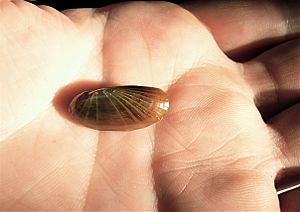Atlantic awning clam facts for kids
Quick facts for kids Atlantic awning clam |
|
|---|---|
 |
|
| Scientific classification | |
| Genus: |
Solemya
|
| Species: |
velum
|
The Atlantic awning clam, also known as Solemya velum, is a special type of clam that lives in the ocean. It's a bivalve, which means it has two shells that can open and close, like a hinge. This clam is a type of mollusc, which is a group of soft-bodied animals. You can find these clams along the eastern coast of North America, from Nova Scotia in Canada all the way down to Florida in the United States.
Contents
A Special Way to Eat
Most animals eat food by hunting or filtering tiny bits from the water. But the Atlantic awning clam has a very unique way to get its meals! Inside its gills (which are like lungs for clams), it has tiny helpers: special bacteria.
Working Together
These bacteria are amazing because they can make their own food. They do this by using chemicals from their environment, a process called chemosynthesis. This is different from plants, which use sunlight (photosynthesis). The bacteria use a gas called hydrogen sulfide, which smells like rotten eggs, to create energy.
This energy helps the bacteria turn carbon dioxide into food. It's like a tiny food factory inside the clam! This special partnership, where two different living things help each other, is called symbiosis. The clam provides a safe home for the bacteria, and the bacteria provide food for the clam.
The Bacteria's Secret
Scientists have studied the genes of these helpful bacteria. They found that the bacteria have genes that allow them to move around. This suggests that these tiny helpers might also be able to live on their own, outside of the clam, if they need to.
Where They Live
Atlantic awning clams live in the soft mud and sand along the coast. They build special burrows, which are like tunnels, in the sediment. These burrows are shaped like the letter "Y".
Why Y-Shaped Burrows?
The Y-shaped burrows are very clever. They help the clam reach two important things:
- Oxygen: One part of the burrow goes up to the seawater, where the clam can get oxygen.
- Hydrogen Sulfide: The other part of the burrow goes deeper into the mud, where there's lots of hydrogen sulfide.
Both oxygen and hydrogen sulfide are needed by the bacteria inside the clam. The bacteria use these chemicals to make food for themselves and for the clam. So, the clam's home helps its tiny food-making partners survive!
Ancient Clam Features
Scientists have also studied the clam's own genetic material, specifically its mitochondrial genome. They found that some parts of the Atlantic awning clam's genes are very similar to those of very old, ancient mollusks. This means the Atlantic awning clam has some features that are closer to the earliest mollusks than many other modern bivalves. It's like a living link to the past!
Images for kids


